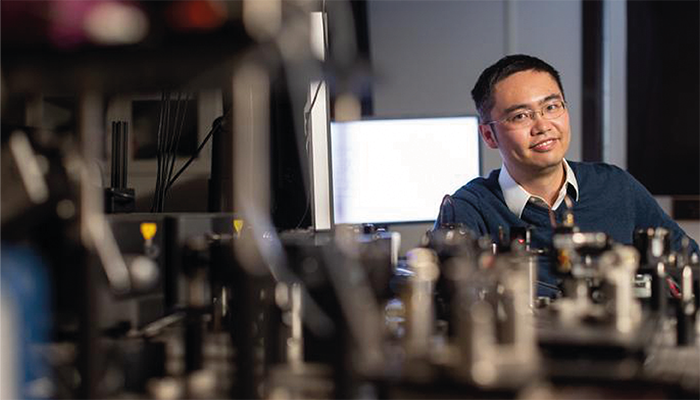
Xiaoji Xu, Credit: Douglas Benedict, Academic Image
This week, we came across three papers demonstrating spectroscopy’s potential to improve disease diagnosis, surgical precision, and post-surgery care – in three different diseases – which we thought made for a pleasing juxtaposition.
The first, a review paper, examined the role of infrared spectroscopy and machine learning for head and neck cancer – the seventh most common cancer worldwide – and precancer diagnosis. The scoping review highlighted “strong preliminary results from the research,” with the highest sensitivity and specificity of 100 percent and an accuracy of 95–96 percent for oral cancer diagnosis applications.
The second paper demonstrates the potential of Raman spectroscopy to improve surgical precision for pediatric epilepsy patients. The researchers used single-cell Raman microspectroscopy to distinguish between focal cortical dysplasia tissue and healthy brain tissue in vitro – which they did with 96 percent accuracy. The findings suggest that Raman spectroscopy, when used during surgery with a fiber optics system, could provide real-time guidance for surgeons.
Finally, in this pilot study, researchers used spectroscopic nuclear magnetic resonance and Fourier transform–infrared approaches to analyze blood plasma from patients with colorectal cancer, before and seven days after surgery. The measurements were combined with statistical analysis and machine learning to generate maps of medical state probability. “From a clinical point of view, one can declare that the present study demonstrates a real potential application,” the researchers concluded.
A handheld point probe Raman spectroscopy system – the UltraProbe – can be used to detect retroperitoneal soft tissue sarcoma in an in vivo setting with accuracy greater than 80 percent across all types of sarcomas and greater than 90 percent for liposarcomas. Link
Researchers improve neural networks to accurately classify and identify microplastics using low-quality Raman spectra under non-ideal experimental conditions. Link
Review of the latest applications of stimulated Raman scattering highlights heavy water probing for studying metabolic dynamics of biomolecules in organisms during aging and diseases. Link
Researchers use terahertz (THz) spectroscopy to unlock physiological and molecular mechanisms for drought resistance of agaves, with potential applications in improving agricultural practices for water-scarce environments. Link
Comparative study on 12 different analytical and experimental approaches for FTIR measurements of microparticles finds that scattering spectral interferents are not necessarily detrimental for classification studies of biological microparticles. Link
“Revolutionizing chemical analysis at the nanoscale”
Congratulations to this year’s 2025 ACS Richard Van Duyne Early Career Award winner: Xiaoji Xu, Associate Professor at Lehigh University, USA! Xu’s research focuses on developing infrared spectroscopic and imaging tools based on the atomic force microscope to measure and visualize chemical compositions and their response to light. His group has developed the peak force infrared microscopy as a new type of photothermal AFM-IR imaging tool.
"I am proud of the work my colleagues pursue and this award is a deserved recognition for Xiaoji's research,” said Robert Flowers, Herbert J. & Ann L. Siegel Dean of the College of Arts and Sciences and Danser Distinguished Faculty Chair of Chemistry, in a press release. ”New tools enable scientific discoveries, and he has been leading the way in his field since he came to Lehigh. By developing cutting-edge techniques, he is revolutionizing chemical analysis at the nanoscale."
How Vesuvius Turned a Man’s Brain to Glass
The first known case of a human brain preserved as natural glass formed when the victim of the 79 CE Vesuvius eruption was exposed to extreme heat before rapidly cooling, according to a new study. The researchers used field emission scanning electron microscopy (FE-SEM), energy-dispersive X-ray spectroscopy (EDS), Raman spectroscopy, and differential scanning calorimetry (DSC) to confirm that the glassy material found inside the skull of an individual from Herculaneum was formed through a process of high-temperature vitrification… Read more
The Mars Sample Return Goldilocks?
Scientists have demonstrated a powerful new method for detecting signs of life in rocks similar to those expected from future Mars sample return missions – a crucial step in developing protocols to handle extraterrestrial materials safely and effectively. The study, led by Yohey Suzuki from the University of Tokyo, Japan, focuses on optical-photothermal infrared (O-PTIR) spectroscopy as a sensitive and minimally destructive technique for biosignature detection in Mars-analogue basalt. Read more
Bird Lungs Reveal Extent of Airborne Microplastic Pollution
Microscopic plastic pollutants are infiltrating the lungs of birds, raising concerns about the potential risks to human health, according to a new study led by researchers at the University of Texas at Arlington. Researchers analyzed lung tissue from 56 birds spanning 51 species collected at Chengdu Tianfu International Airport in China. Using laser direct infrared (LDIR) spectroscopy and pyrolysis gas chromatography-mass spectrometry (Py-GC-MS), they detected a high prevalence of microplastics and nanoplastics in the birds’ respiratory systems... Read more




